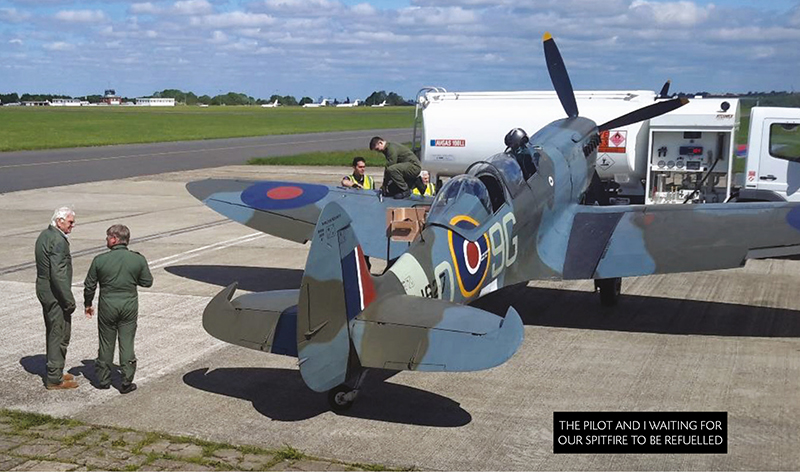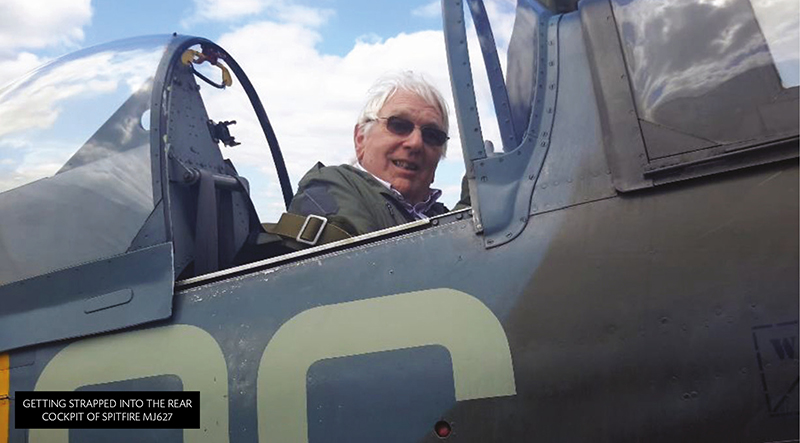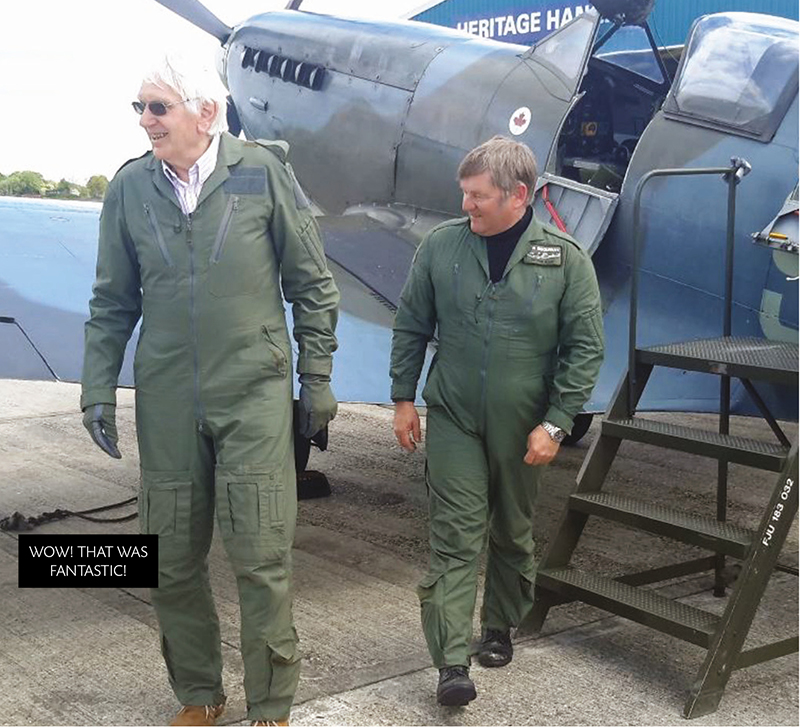RAF Biggin Hill, an airfield with its iconic name forever associated with The Battle of Britain, Spitfires and Hurricanes, is today a busy commercial airport some 12 miles south of central London. It is now known as “London Biggin Hill Airport”; it specialises in general aviation, handling a spectrum of traffic from private aviation to large business jets.

Drive through the main gate and along the main road past the various aviation linked businesses and you soon reach The Heritage Hanger. This is not a museum but a working hanger; a restoration facility dedicated to putting Spitfires back into the air. This building is a veritable Aladdin’s Cave full of treasure in the form of vintage (mainly WW2) aircraft and sundry vehicles. Glorious Spitfires in various stages of restoration, Merlin engines, a Hawker Hurricane and an Me109 are all being restored by skilled engineers. Every aircraft, all privately owned, will eventually take to the skies again. For an aviation enthusiast like me it is an absolute Heaven on Earth. Even better than a previous visit just to see all these fabulous aircraft I was now, thanks to the wonderful generosity of my lovely wife Val, to actually fly in Spitfire MJ627. This aircraft was built in Castle Bromwich originally as a single seat fighter in 1943. It saw action after D‑Day and was credited with shooting down an Me 109. It was converted to a 2 seat trainer after the war.
On the great day I was asked to arrive at the Heritage Hanger by 8.30am so my wife and I and 2 good friends stayed overnight in a nearby hotel. At least, by doing this we avoided the dreaded A21 rush hour traffic! I most certainly didn’t want to be late for my date with an aristocratic lady.
Fitted out with a sage green flight suit – amazingly they had one that fitted my six foot three inch frame – I was asked to watch two videos. The first explained in great detail the differences and possible dangers flying in a vintage warbird when compared with a commercial airline flight. It is pointed out that there is only one pilot and one engine – if either become incapacitated in flight it could spell trouble! Rest assured, we were advised, the pilot is very experienced and will know exactly what to do if the engine blows up just at the point of lift-off at the end of the runway.
However, as stated in video 2, it might be a good idea if you, the passenger in the rear cockpit, knew how to bale out just in case things do go horribly wrong! The necessary actions for a swift exit are called the emergency arc since as you sit, facing forward, you have to:
• At the 3 o’clock position, find the yellow lever (a bit like a car’s hand brake) and lower your seat.
• Next, at 12 o’clock, above you head, pull the red knob and hopefully the canopy will be ejected.
• Then, at 9 o’clock on the left, pull the lever which will open the small side flap.
Finally unstrap, and roll out! The parachute is attached to a static line so should open by itself. If this doesn’t happen then pull on the D‑ring across your chest and do-it-yourself.
Note that if instructions 2 or 3 prove difficult, a red crowbar is thoughtfully provided to assist your exit; this is attached to the inside of the side flap.
In the event of a forced landing with you still in situ then the crash position was clearly demonstrated.
During both videos it is stressed that, if you have changed your mind about this flight, then a full refund will be made no questions asked! At the same time it was stressed that the pilot was highly trained and experienced and that the aircraft itself was better cared for and serviced than the Queen’s cars!
The pilot has a rear view mirror – not to spot the approach of enemy aircraft but to see if his passenger is OK. A thumbs up sign shows that all is well. It is an alternative way for the passenger to attract the attention of the pilot should verbal contact be lost.
MJ267 had to be refuelled before my flight. In its original single-seat life it had 2 fuel tanks; one in front and one behind the pilot (comforting!). When converted to a 2 seat trainer the rear tank was removed to install the second cockpit and two small tanks placed in each wing.

Clad in my flying suit and flame proof gloves I strode purposely across the tarmac towards my beloved Spitfire completely ready to save my country from the dreaded Hun! In reality, I met and shook hands with my friendly pilot, Don Sigournay, a retired Royal Navy Harrier Jet pilot.
A set of steps help you to get up to the rear cockpit. I was not in the least worried about the flight but as I do suffer from claustrophobia I did wonder how I would feel in that cramped space with a bubble of Perspex over me. Hold on to the front screen, stand on the seat and lower yourself in. There is a surprising amount of leg room – a good job since I am 6 foot 3 inches tall and suffer agonies when on an economy class commercial flight. The cockpit is narrow but there is plenty of headroom. A young assistant hands me the helmet with built in microphone and earphones. The parachute is already behind me and is strapped on, then the seat straps which hold you firmly down. The pilot checks communication and asks that I adjust the seat until I can see his face grinning at me in his rear view mirror. The joystick springs into life and is moving between my legs as the pilot checks the control movements. Thank goodness that I have been doing morning exercises to reduce my paunch! Imagine if the pilot pulls back the stick only to find movement is restricted by the bulging stomach of his passenger. Fancy putting that in an accident report!
Then there is the smell of that cockpit – a unique, evocative and never-to-be-forgotten mixture of fuel, engine oil and fumes, dope, and well…just Spitfire. I wish it could be bottled!
The chap helping me hands over a piece of paper and wants my signature. Did I read it? Not really. I probably absolved the entire company from any responsibility for killing me. The canopy was closed and my mind was totally occupied with this incredible experience and any thoughts of claustrophobia forgotten (is that what is called mind over matter?) The pilot asks me again if I am happy to proceed. Of course I am! With a throaty cough and two small clouds of smoke the wonderful Merlin engine bursts into life and the huge 4 bladed propeller jerks into action and the cockpit shudders. A pity the sound is now muffled by my helmet – not the same iconic unforgettable Merlin roar heard when outside the aircraft.I feel the rudder bar moving as MJ267 is manoeuvred away from the hard standing and onto the taxiway. Forward visibility in a Spitfire isn’t good on the ground even for me in my elevated position, higher than the pilot. We weave from side to side as we move towards the main runway. Conditions are perfect with blue sky and a few fluffy clouds; the wind direction good – straight down the runway.
We stop for a while just short of the runway; the pilot revs the engine to check the magnetos; one more check of the control surfaces and a quick confirmation from the control tower.

“Are you OK to go Geoff”, asks the pilot once again. “Too right!” is my enthusiastic reply. For goodness sake I think, I’m actually sitting in a genuine Spitfire about to take off. It’s not a dream – this is for real!
“We don’t need full throttle – she will lift off with only around 70% of available power”, said my pilot. “We must be gentle with this old lady”. I hear the engine developing its magnificent energy with a characteristic bellow from the twelve exhaust stubs and feel the surge pushing me back into the seat. The take-off run is amazingly short, the ride bumpy – this is real seat of your pants flying.
We do a steep bank to the right and head off in the general direction of the Thames estuary. I can see the sky scrapers of the Canary Wharf in the distance. We cross over the M20 and M25 motor ways and soon the Queen Elizabeth Bridge comes into view. The pilot keeps up a constant commentary, “Just look at the traffic jam leading into the Dartford Tunnel – we’re much better off up here!” Too right we are. I’m actually flying in a Spitfire! “How cool is that?” As my lovely granddaughter Phoebe would say. The Merlin engine burbles away healthily as the pilot continues his chatter pointing out various landmarks. I wondered what it would be like if, instead of sightseeing, we had to constantly look around for enemy aircraft intent on shooting us down or bombing our airfield.
“Look, there’s Brands Hatch race track. Can you see the cars – they must be having a practise run. OK Geoff, would you like to experience a roll?”
“Absolutely” I reply with the confidence of a 15 minute Spitfire veteran. It was both a strange and amazing experience! Nose down to pick up a bit of speed then over we go. Even though you are strapped securely into your seat, when the ground is where the sky should be and vice-versa your brain tells you that you are going to fall! No sooner had I grabbed the side of the cockpit than we were back the right way up! I noticed that, during the roll, the turn and bank indicator in front of me was having a nervous breakdown and only settled down to do its job when we resumed normal flight!
Then came the question from the pilot that I had long anticipated, “Right Geoff, would you like to fly her?” He didn’t wait for my reply, but continued, “She is very sensitive. Hold the stick lightly between your thumb and forefinger. If you move it more than a centimetre we’ll be doing aerobatics! OK Geoff, you have control”. I could see in the mirror that he had both hands in the air – I was in control. Bloody fantastic! He was right, the slightest nudge on the stick and the response was immediate. No wonder this beautiful aircraft was a pilot’s favourite. I remembered what one wartime veteran Spitfire pilot once said in a TV interview, “You don’t fly a Spitfire – you strap it on and you become part of it!” A blissful 10 minutes passed all too quickly before I reluctantly handed back control to the pilot and we headed towards Biggin Hill.
As we approached the airfield I tried to imagine how those young wartime pilots must have felt as they approached the same runway after surviving another combat with the enemy. Normally, when coming on to land’ the pilot will fly alongside the runway on a down-wind leg, continue for quite a while then gently turn 180 degrees to line-up for the final approach to the runway, heading
into the wind. Don Sigournay demonstrates his long aircraft carrier experience by flying the down-wind leg but as the end of the runway is reached he performs a steep bank and sideslip to reach the threshold in one fluid movement. The flaps are lowered, the nose rises slightly, the revs are increased and we literally kiss the runway in a perfect landing. On this mark of Spitfire two little indicators come out of the wings close to the trailing edge. These confirm to the pilot that the flaps have been deployed – there is no indication of this on the cockpit instruments. We trundle back to the hard standing where my wife and friends are waiting for my safe return. And so ended the most wonderful, incredible and unforgettable experience of my life. Thank you Val!
©Geoff Collins, March 2018